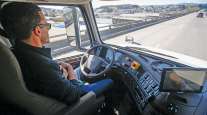Colorado DOT Purchases World’s First Automated Self-Driving Construction Vehicle

When Robert Roy was helping to create the world’s first self-driving construction truck, he traveled across the country and talked to people in the construction industry. One of the people he spoke with, the president of a company in Louisiana, told him the story of how one of his employees almost died while working on a highway.
The employee’s job was to drive a “crash truck” — a vehicle designed to crash into a stray car that might hit other crew members or vehicles. Crash trucks typically follow crews and other vehicles along the highway as they paint or sweep on the highway, acting as a buffer between crews and traffic. The job, Roy said, is considered the most dangerous in the construction industry.
Because of that, the Colorado Department of Transportation agreed to contract with Roy’s company, Royal Truck and Equipment, to purchase the world’s first automated crash truck.
“People are hit and killed in that truck all the time,” Roy said. “We’re trying to remove people from the most dangerous job.”
Roy’s company worked with Kretos Defense and Security Solutions to make the automated truck a reality. The concept is simple. A transmitter is placed in one vehicle — such as a truck used to paint the highway — and it sends an electronic signal to a transmitter in the crash truck, causing the crash truck to follow the lead vehicle. A crew member drives the lead vehicle while the crash truck follows, acting as a shield in case of collision, as always. The only difference is there is no one inside the crash truck.
The transmitters can be fitted to any vehicle, Roy said.
“It makes them practical and affordable,” he added.
Roy made the comment Aug. 18 in Fort Collins where CDOT unveiled the world’s first automated crash truck. After the conference, two CDOT employees climbed into the front and back cabs of a massive orange stripe truck, used to paint lines on the highway. They drove a nearby stretch of road while the crash truck followed, devoid of drivers or passengers.
“If the lead truck makes a left turn, the (crash) truck makes a left turn,” Roy said from the shade of a nearby tree, gesturing to the two vehicles on the road.
Right now, CDOT’s crash truck is the only one of its kind in the world. It’s not on the road yet, but director Shailen Bhatt said he expects to have it in a construction zone this fall. He was impressed by the truck.
He said the department wants to work through every possible scenario before putting the truck on the road in a few months. Employees need to know, for example, how the truck would behave if a vehicle did strike it. But he was adamant about using it.
“It’s hard, given the performance we’ve seen today, to see us not purchasing more of these,” Bhatt said.
Fatal statistics
Construction zones on highways are dangerous, said Robert Roy, president of Royal Truck and Equipment. He said more than 750 people — drivers and construction crew members — died in work zone crashes across the country last year.
Mark Knopp, an administrator for the Federal Highway Administration, agreed. He said a work zone crash occurs every 5.4 minutes, and 12 of those crashes each week will be fatal. He added in four of five cases, the driver of the vehicle is the person injured in a work zone crash.
Distributed by Tribune Content Agency, LLC




